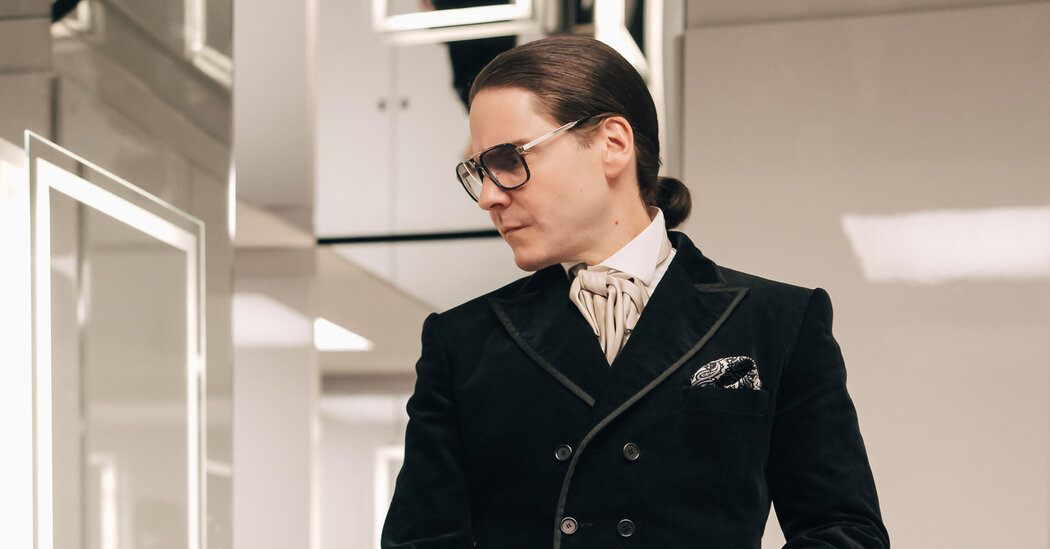There’s a scene late in “Becoming Karl Lagerfeld,” the six-part streaming series on Hulu about the famed German designer’s early Parisian career, in which a young Karl talks to his mother, who has just suffered a stroke and has been installed in a extensive castle in the French countryside. He’s desperate. Without her, Mr. Lagerfeld says, there will be no one to know the real him.
“Who cares?” she replies effectively, suggesting that the created self is so much more interesting.
For decades, this was essentially fashion dogma. Great designers were often synonymous with fantasists and myth makers, not only when it came to their clothes, but also their lives. Their homes were extraordinary settings; their self-presentation as invention; their speech was populated by exaggerated edicts and ultimatums.
Their fans consumed these caricatures in the same way they consumed their clothing, with the image fueling the popular narrative of the creative genius. Few were better at this than Mr. Lagerfeld, who was a cartoon in himself with his powdered ponytail, dark glasses and fingerless motocross gloves, but he was far from the only one.
Dior with its white coats fit the bill; Chanel also did the same with her pearl necklaces and cigarette holders. John Galliano with his costumes did that too, as did Tom Ford with his porno sunglasses and undone shirts.
And so it was for years. Recently, however, another trend has emerged. It’s one that takes the form of three streaming series dedicated to revealing the designers behind the clothes; to tear off the masks of the monstres sacrés and expose them in all their human fallibility.
First to appear was ‘Cristóbal Balenciaga’, a look at the Spanish master’s career and the trauma he suffered as a closeted gay man and with the advent of ready-to-wear. (That series, which aired in several countries earlier this year, isn’t yet available in the United States.) Then came “The New Look,” which focused on Christian Dior, his daddy issues and dependence on tarot cards, and Coco Chanel and the terrible moral choices designers made to keep their businesses afloat during World War II.
“Becoming Karl,” which depicts the rivalry between Mr. Lagerfeld and his colleague Yves Saint Laurent, focuses on Mr. Lagerfeld’s seemingly enormous inferiority complex and the rivalry between the two men for the love of Jacques de Bascher. It’s simply the latest entrant in a new genre that you could call: “Designers, they’re just like us!”
But do we want that too?
Film has been dancing around fashion for decades, ever since Kay Thompson’s ‘Think pink!’ exclaimed. in 1957’s “Friends Face,” drawn to the subject for the razzle-dazzle it seems to promise. With a few notable exceptions, the result is often exaggerated or absurd, in part because it is difficult to dramatize an industry that is already in the process of dramatizing itself. That’s why documentaries like ‘Dior and I’ or ‘Valentino: The Last Emperor’ seem more effective. These new biopics try to find a middle ground.
But turning what has become an abstract, widely digestible brand into an actual person once again raises the complicated question of how to think about the relationship between the artist and his art. Whether or not you wear Chanel or Dior, they have become part of the shared cultural vernacular, their style so ubiquitous that it serves as a common reference point. But if their creators, who have reshaped wardrobes and with them the instruments of identity around the world, are themselves identified in all their vulnerability and occasionally ugliness, does that make their legacy more attractive, or less so?
“Becoming Karl,” which covers Mr. Lagerfeld’s career at Chloé and Fendi and ends with his job offer at Chanel, the brand that really made him famous, manages to turn around the unlikely feat of Mr. Lagerfeld, who is both an extraordinary talented designer as a pretty terrible person – racist, sizeist, demanding, cruel but also brilliant and erudite – in a sympathetic character. There’s Karl self-medicating with chocolate, tying himself up in a corset and dancing alone in his room rather than face the possibility of rejection. There is pain beneath the pantomime of fabulosity.
By limiting its scope to the time before Mr. Lagerfeld’s fame and power allowed him to preach with impunity, and by shifting the blame to his terrible mother and a Parisian world that looked down on him as a German (Pierre Bergé, the partner of Yves Saint Laurent, is the villain here), the series offers an alternative story. Just as “The New Look” portrays Dior as a trembling flower, a victim of a terrible father, and Chanel as a product of her experience as a single woman fighting for her own survival. If she got a friend hooked on drugs and tried to use Nazi laws to win back her business… well, she has to.
Designing clothes isn’t necessarily a dramatic act, which may be why the showrunners decided to focus on the people. Yet these characters – Dior, Chanel, Lagerfeld, Balenciaga – not only changed the way we dress, but also the way we think about fashion. Chanel freed women from the corset and created, among other things, the jacket-as-vest and the little black dress. Dior invented the New Look and inspired a generation of shoppers. Balenciaga gave us the sack dress, the egg coat, the baby doll and the belief in fashion as a religion. Lagerfeld took all that and made it part of pop culture.
They created legacies powerful enough to resonate through the decades and signatures distinct enough to make their names live on in the hands of others, which is why they loom so large in the popular imagination. That’s why they’re important in the first place. Why these series could even exist.
And yet the subjects of the series always understood that the essence of their success was a mirage: that what they were selling was the magical promise of transformation through stuff; through wool, silk and chiffon; by the glorious illusion of chic associated with their names. Ultimately not their reality.





